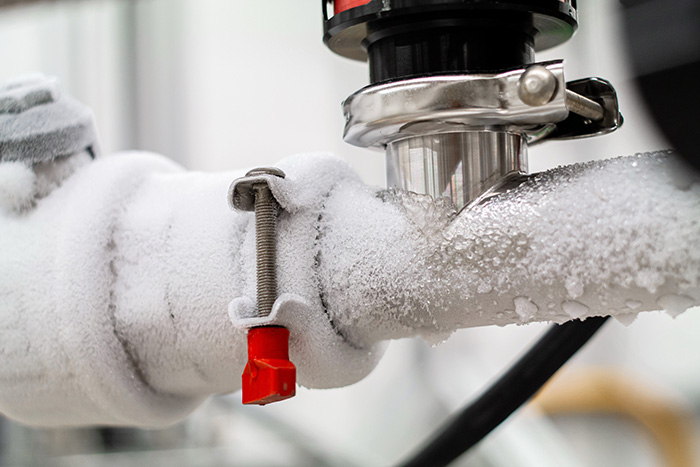Tips to Keep Your Pipes from Freezing Damage: Important Tips
Tips to Keep Your Pipes from Freezing Damage: Important Tips
Blog Article
What're your opinions with regards to 6 Ways to Prevent Frozen Pipes?

Cold weather can damage your plumbing, particularly by freezing pipelines. Right here's exactly how to prevent it from happening and what to do if it does.
Intro
As temperatures decline, the danger of frozen pipelines boosts, potentially causing pricey fixings and water damage. Recognizing exactly how to avoid frozen pipes is crucial for house owners in cool climates.
Prevention Tips
Shielding susceptible pipelines
Cover pipes in insulation sleeves or utilize warmth tape to protect them from freezing temperatures. Focus on pipelines in unheated or exterior areas of the home.
Heating methods
Maintain indoor areas effectively heated, especially areas with pipes. Open up cabinet doors to enable cozy air to circulate around pipes under sinks.
Exactly how to determine icy pipelines
Try to find lowered water circulation from taps, uncommon smells or sounds from pipelines, and noticeable frost on revealed pipelines.
Long-Term Solutions
Architectural modifications
Think about rerouting pipes away from exterior wall surfaces or unheated locations. Include additional insulation to attics, basements, and crawl spaces.
Updating insulation
Purchase top notch insulation for pipes, attic rooms, and wall surfaces. Proper insulation aids preserve constant temperatures and minimizes the danger of icy pipes.
Protecting Outside Pipes
Yard hoses and outside faucets
Detach and drain pipes yard pipes prior to winter months. Set up frost-proof spigots or cover outside taps with shielded caps.
Comprehending Icy Pipelines
What triggers pipelines to ice up?
Pipes ice up when subjected to temperatures listed below 32 ° F (0 ° C) for extended periods. As water inside the pipelines ices up, it broadens, taxing the pipeline walls and potentially creating them to burst.
Threats and problems
Icy pipelines can result in water disturbances, home damages, and expensive fixings. Ruptured pipes can flooding homes and trigger considerable architectural damages.
Indications of Frozen Pipes
Determining frozen pipelines early can avoid them from bursting.
What to Do If Your Pipelines Freeze
Immediate actions to take
If you believe icy pipes, maintain faucets open up to soothe pressure as the ice thaws. Utilize a hairdryer or towels taken in hot water to thaw pipelines slowly.
Conclusion
Stopping frozen pipes calls for proactive actions and quick actions. By recognizing the causes, indications, and safety nets, property owners can protect their plumbing throughout cold weather.
5 Ways to Prevent Frozen Pipes
Drain Outdoor Faucets and Disconnect Hoses
First, close the shut-off valve that controls the flow of water in the pipe to your outdoor faucet. Then, head outside to disconnect and drain your hose and open the outdoor faucet to allow the water to completely drain out of the line. Turn off the faucet when done. Finally, head back to the shut-off valve and drain the remaining water inside the pipe into a bucket or container. Additionally, if you have a home irrigation system, you should consider hiring an expert to clear the system of water each year.
Insulate Pipes
One of the best and most cost-effective methods for preventing frozen water pipes is to wrap your pipes with insulation. This is especially important for areas in your home that aren’t exposed to heat, such as an attic. We suggest using foam sleeves, which can typically be found at your local hardware store.
Keep Heat Running at 65
Your pipes are located inside your walls, and the temperature there is much colder than the rest of the house. To prevent your pipes from freezing, The Insurance Information Institute suggests that you keep your home heated to at least 65 degrees, even when traveling. You may want to invest in smart devices that can keep an eye on the temperature in your home while you’re away.
Leave Water Dripping
Moving water — even a small trickle — can prevent ice from forming inside your pipes. When freezing temps are imminent, start a drip of water from all faucets that serve exposed pipes. Leaving a few faucets running will also help relieve pressure inside the pipes and help prevent a rupture if the water inside freezes.
Open Cupboard Doors
Warm your kitchen and bathroom pipes by opening cupboards and vanities. You should also leave your interior doors ajar to help warm air circulate evenly throughout your home.

Hopefully you liked our post on Preventing and dealing with frozen pipes. Many thanks for taking time to read through our article. So long as you enjoyed our article kindly be sure to share it. I appreciate reading our article about 6 Ways to Prevent Frozen Pipes.
Visit My Web Page Report this page